#include <tinyxml.h>
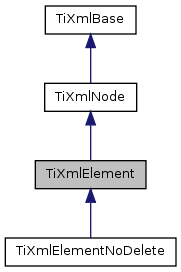
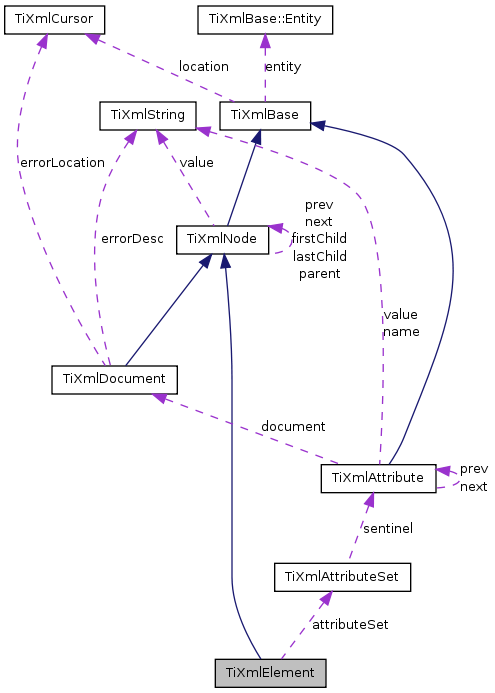
Public Member Functions
- TiXmlElement (const char *in_value)
- TiXmlElement (const TiXmlElement &)
- void operator= (const TiXmlElement &base)
- virtual ~TiXmlElement ()
- const char * Attribute (const char *name) const
- const char * Attribute (const char *name, int *i) const
- const char * Attribute (const char *name, double *d) const
- int QueryIntAttribute (const char *name, int *value) const
- int QueryDoubleAttribute (const char *name, double *value) const
- QueryDoubleAttribute examines the attribute - see QueryIntAttribute().
- QueryDoubleAttribute examines the attribute - see QueryIntAttribute().
- void SetAttribute (const char *name, const char *value)
- void SetAttribute (const char *name, int value)
- void SetDoubleAttribute (const char *name, double value)
- void RemoveAttribute (const char *name)
- TiXmlAttribute * FirstAttribute () const
- TiXmlAttribute * LastAttribute () const
- virtual TiXmlNode * Clone () const
- virtual void Print (FILE *cfile, int depth) const
- virtual const char * Parse (const char *p, TiXmlParsingData *data, TiXmlEncoding encoding)
Protected Member Functions
- void CopyTo (TiXmlElement *target) const
- void ClearThis ()
- virtual void StreamOut (TiXmlOutStream *out) const
- const char * ReadValue (const char *in, TiXmlParsingData *prevData, TiXmlEncoding encoding)
Private Attributes
Detailed Description
The element is a container class. It has a value, the element name, and can contain other elements, text, comments, and unknowns. Elements also contain an arbitrary number of attributes.
Constructor & Destructor Documentation
| TiXmlElement::TiXmlElement | ( | const char * | in_value | ) |
Construct an element.
References TiXmlNode::firstChild, TiXmlNode::lastChild, and TiXmlNode::value.
Referenced by Clone().

| TiXmlElement::TiXmlElement | ( | const TiXmlElement & | copy | ) |
References CopyTo(), TiXmlNode::firstChild, and TiXmlNode::lastChild.

| TiXmlElement::~TiXmlElement | ( | ) | [virtual] |
Member Function Documentation
| void TiXmlElement::operator= | ( | const TiXmlElement & | base | ) |
| const char * TiXmlElement::Attribute | ( | const char * | name | ) | const |
Given an attribute name, Attribute() returns the value for the attribute of that name, or null if none exists.
References attributeSet, TiXmlAttributeSet::Find(), and TiXmlAttribute::Value().
Referenced by Attribute(), and GetCWBFormattedStringRecursive().


| const char * TiXmlElement::Attribute | ( | const char * | name, | |
| int * | i | |||
| ) | const |
Given an attribute name, Attribute() returns the value for the attribute of that name, or null if none exists. If the attribute exists and can be converted to an integer, the integer value will be put in the return 'i', if 'i' is non-null.
References Attribute().

| const char * TiXmlElement::Attribute | ( | const char * | name, | |
| double * | d | |||
| ) | const |
Given an attribute name, Attribute() returns the value for the attribute of that name, or null if none exists. If the attribute exists and can be converted to an double, the double value will be put in the return 'd', if 'd' is non-null.
References Attribute().

| int TiXmlElement::QueryIntAttribute | ( | const char * | name, | |
| int * | value | |||
| ) | const |
QueryIntAttribute examines the attribute - it is an alternative to the Attribute() method with richer error checking. If the attribute is an integer, it is stored in 'value' and the call returns TIXML_SUCCESS. If it is not an integer, it returns TIXML_WRONG_TYPE. If the attribute does not exist, then TIXML_NO_ATTRIBUTE is returned.
References attributeSet, TiXmlAttributeSet::Find(), and TiXmlAttribute::QueryIntValue().

| int TiXmlElement::QueryDoubleAttribute | ( | const char * | name, | |
| double * | value | |||
| ) | const |
QueryDoubleAttribute examines the attribute - see QueryIntAttribute().
References attributeSet, TiXmlAttributeSet::Find(), and TiXmlAttribute::QueryDoubleValue().

| void TiXmlElement::SetAttribute | ( | const char * | name, | |
| const char * | value | |||
| ) |
Sets an attribute of name to a given value. The attribute will be created if it does not exist, or changed if it does.
References TiXmlAttributeSet::Add(), attributeSet, TiXmlAttributeSet::Find(), TiXmlNode::GetDocument(), TiXmlDocument::SetError(), TiXmlAttribute::SetValue(), TIXML_ENCODING_UNKNOWN, and TiXmlBase::TIXML_ERROR_OUT_OF_MEMORY.
Referenced by CopyTo(), SetAttribute(), and SetDoubleAttribute().
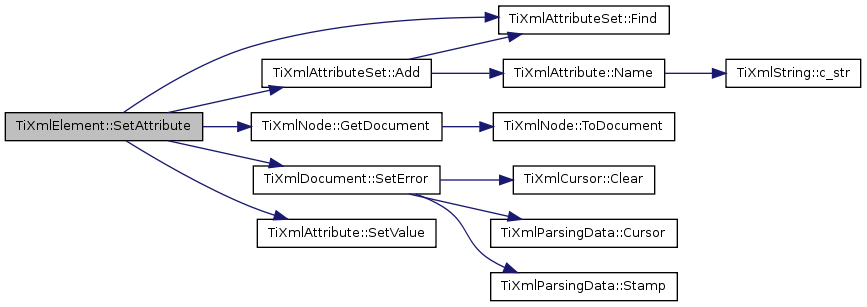

| void TiXmlElement::SetAttribute | ( | const char * | name, | |
| int | value | |||
| ) |
Sets an attribute of name to a given value. The attribute will be created if it does not exist, or changed if it does.
References SetAttribute().

| void TiXmlElement::SetDoubleAttribute | ( | const char * | name, | |
| double | value | |||
| ) |
Sets an attribute of name to a given value. The attribute will be created if it does not exist, or changed if it does.
References SetAttribute().

| void TiXmlElement::RemoveAttribute | ( | const char * | name | ) |
Deletes an attribute with the given name.
References attributeSet, TiXmlAttributeSet::Find(), and TiXmlAttributeSet::Remove().

| TiXmlAttribute* TiXmlElement::FirstAttribute | ( | ) | const [inline] |
Access the first attribute in this element.
References attributeSet, and TiXmlAttributeSet::First().

| TiXmlAttribute* TiXmlElement::LastAttribute | ( | ) | const [inline] |
Access the last attribute in this element.
References attributeSet, and TiXmlAttributeSet::Last().

| TiXmlNode * TiXmlElement::Clone | ( | ) | const [virtual] |
Creates a new Element and returns it - the returned element is a copy.
Implements TiXmlNode.
References CopyTo(), TiXmlElement(), and TiXmlNode::Value().
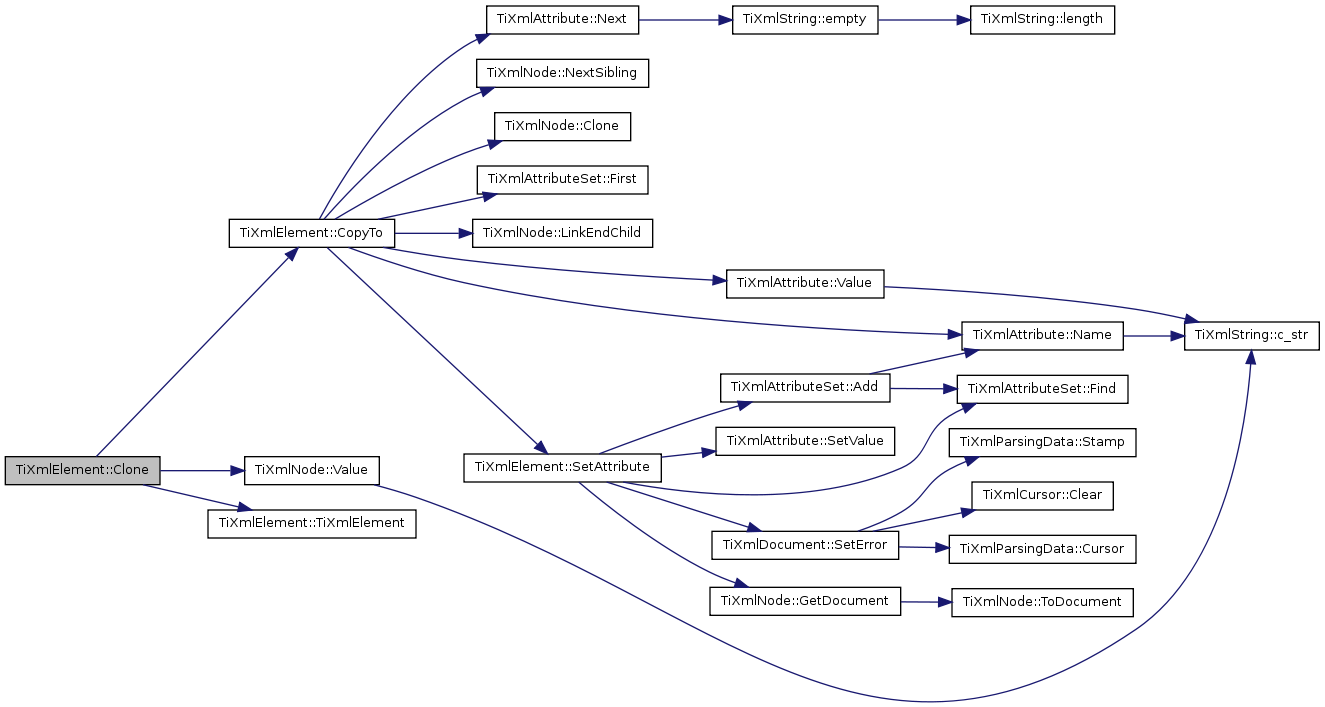
| void TiXmlElement::Print | ( | FILE * | cfile, | |
| int | depth | |||
| ) | const [virtual] |
All TinyXml classes can print themselves to a filestream. This is a formatted print, and will insert tabs and newlines.
(For an unformatted stream, use the << operator.)
Implements TiXmlBase.
References attributeSet, TiXmlString::c_str(), TiXmlAttributeSet::First(), TiXmlNode::firstChild, TiXmlNode::lastChild, TiXmlAttribute::Next(), TiXmlNode::NextSibling(), TiXmlBase::Print(), TiXmlNode::ToText(), and TiXmlNode::value.

| const char * TiXmlElement::Parse | ( | const char * | p, | |
| TiXmlParsingData * | data, | |||
| TiXmlEncoding | encoding | |||
| ) | [virtual] |
Implements TiXmlBase.
References TiXmlAttributeSet::Add(), attributeSet, TiXmlParsingData::Cursor(), TiXmlAttributeSet::Find(), TiXmlNode::GetDocument(), TiXmlBase::IsWhiteSpace(), TiXmlBase::location, TiXmlAttribute::Name(), TiXmlAttribute::Parse(), TiXmlBase::ReadName(), ReadValue(), TiXmlAttribute::SetDocument(), TiXmlDocument::SetError(), TiXmlAttribute::SetValue(), TiXmlBase::SkipWhiteSpace(), TiXmlParsingData::Stamp(), TiXmlBase::StringEqual(), TiXmlBase::TIXML_ERROR_FAILED_TO_READ_ELEMENT_NAME, TiXmlBase::TIXML_ERROR_OUT_OF_MEMORY, TiXmlBase::TIXML_ERROR_PARSING_ELEMENT, TiXmlBase::TIXML_ERROR_PARSING_EMPTY, TiXmlBase::TIXML_ERROR_READING_ATTRIBUTES, TiXmlBase::TIXML_ERROR_READING_END_TAG, TIXML_STRING, TiXmlAttribute::Value(), and TiXmlNode::value.
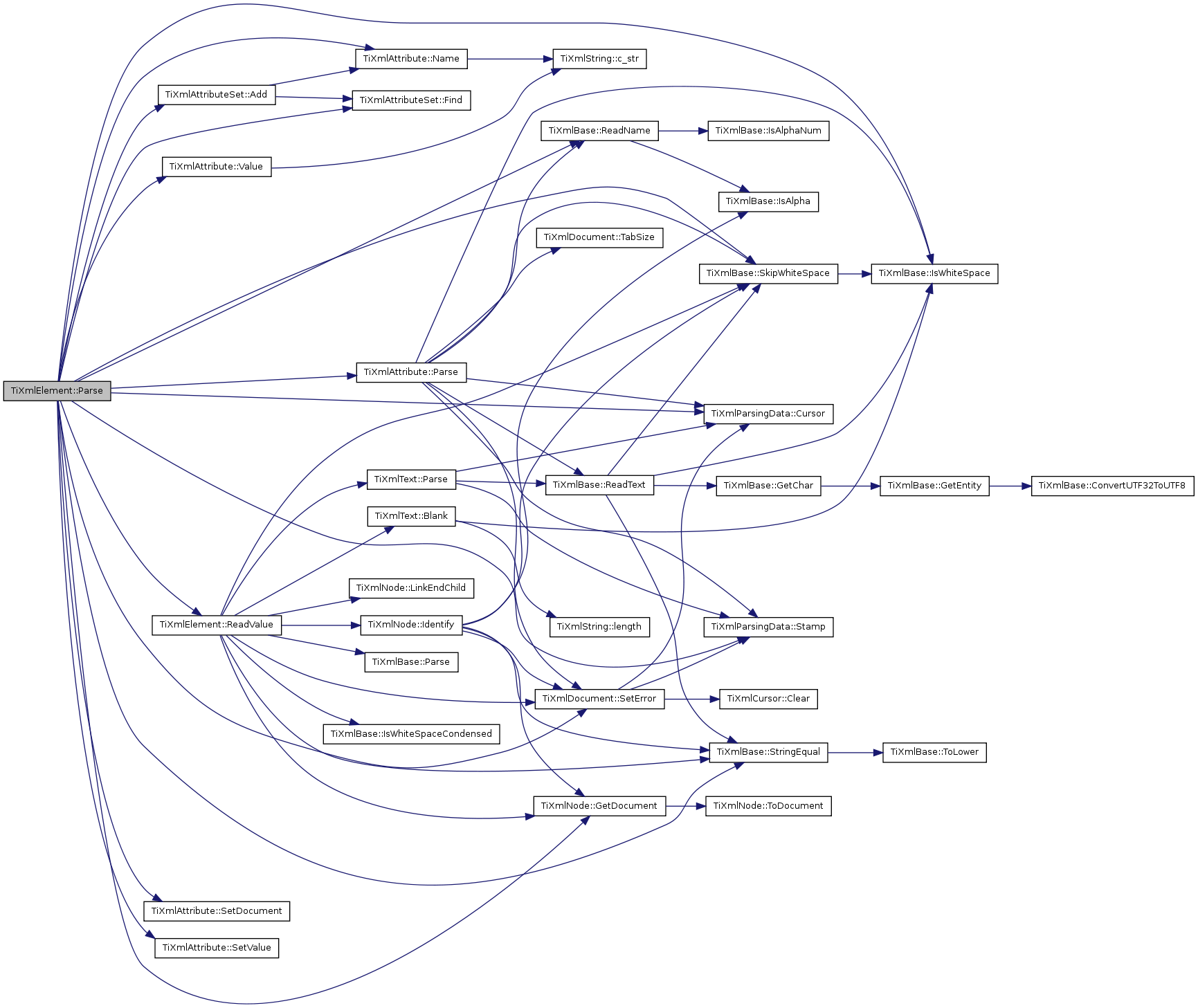
| void TiXmlElement::CopyTo | ( | TiXmlElement * | target | ) | const [protected] |
References attributeSet, TiXmlNode::Clone(), TiXmlAttributeSet::First(), TiXmlNode::firstChild, TiXmlNode::LinkEndChild(), TiXmlAttribute::Name(), TiXmlAttribute::Next(), TiXmlNode::NextSibling(), SetAttribute(), and TiXmlAttribute::Value().
Referenced by Clone(), operator=(), and TiXmlElement().
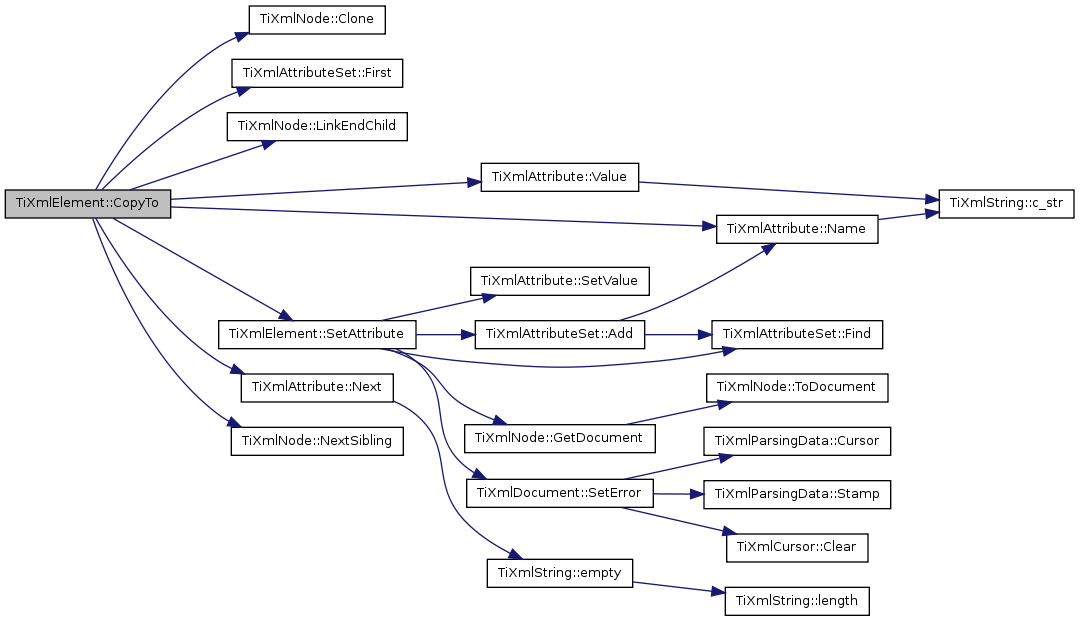
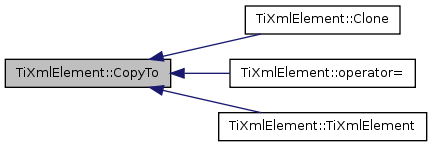
| void TiXmlElement::ClearThis | ( | ) | [protected] |
References attributeSet, TiXmlNode::Clear(), TiXmlAttributeSet::First(), and TiXmlAttributeSet::Remove().
Referenced by operator=(), and ~TiXmlElement().
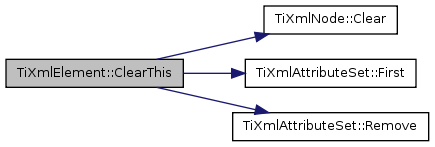

| void TiXmlElement::StreamOut | ( | TiXmlOutStream * | out | ) | const [protected, virtual] |
Implements TiXmlBase.
References attributeSet, TiXmlAttributeSet::First(), TiXmlNode::firstChild, TiXmlAttribute::Next(), TiXmlNode::NextSibling(), TiXmlBase::StreamOut(), TiXmlAttribute::StreamOut(), and TiXmlNode::value.

| const char * TiXmlElement::ReadValue | ( | const char * | in, | |
| TiXmlParsingData * | prevData, | |||
| TiXmlEncoding | encoding | |||
| ) | [protected] |
References TiXmlText::Blank(), TiXmlNode::GetDocument(), TiXmlNode::Identify(), TiXmlBase::IsWhiteSpaceCondensed(), TiXmlNode::LinkEndChild(), TiXmlBase::Parse(), TiXmlText::Parse(), TiXmlDocument::SetError(), TiXmlBase::SkipWhiteSpace(), TiXmlBase::StringEqual(), TiXmlBase::TIXML_ERROR_OUT_OF_MEMORY, and TiXmlBase::TIXML_ERROR_READING_ELEMENT_VALUE.
Referenced by Parse().
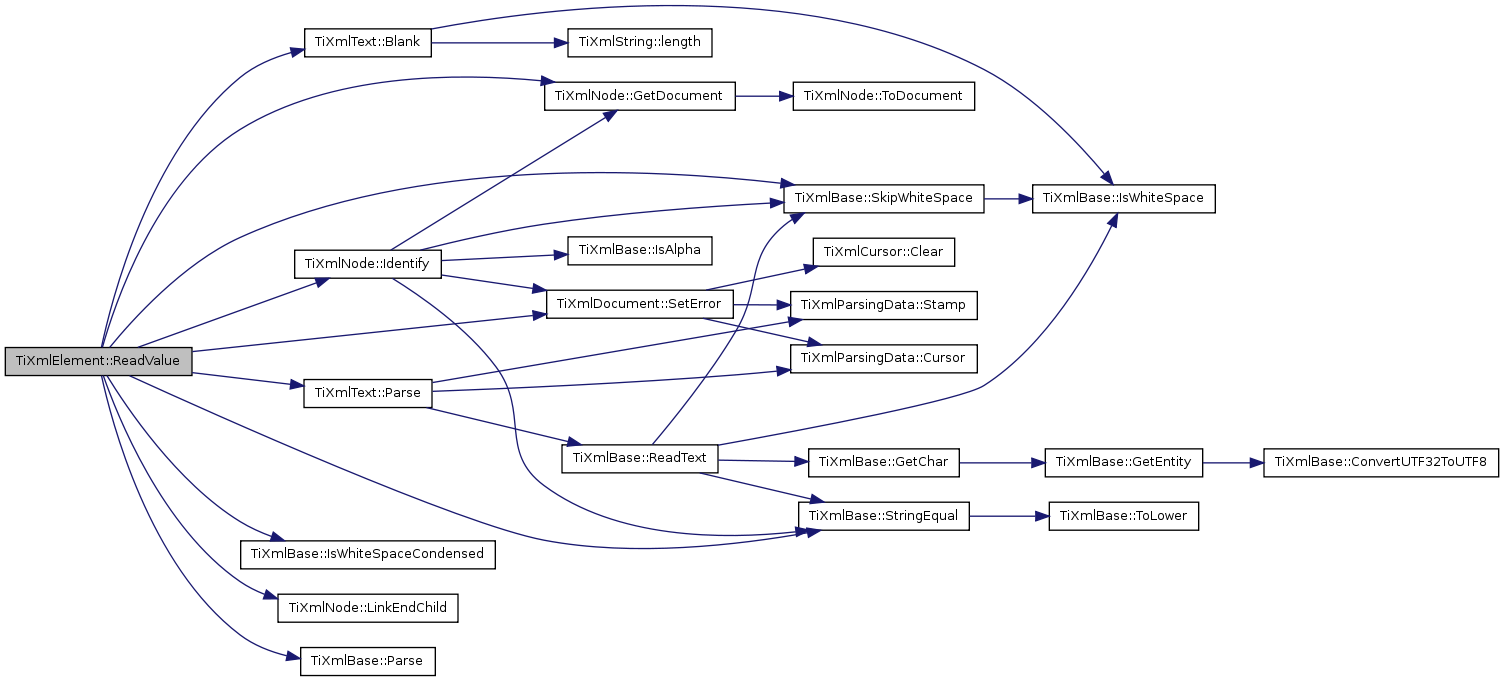

Member Data Documentation
TiXmlAttributeSet TiXmlElement::attributeSet [private] |
Referenced by Attribute(), ClearThis(), CopyTo(), FirstAttribute(), LastAttribute(), Parse(), Print(), QueryDoubleAttribute(), QueryIntAttribute(), RemoveAttribute(), SetAttribute(), and StreamOut().
The documentation for this class was generated from the following files:


 1.7.1
1.7.1